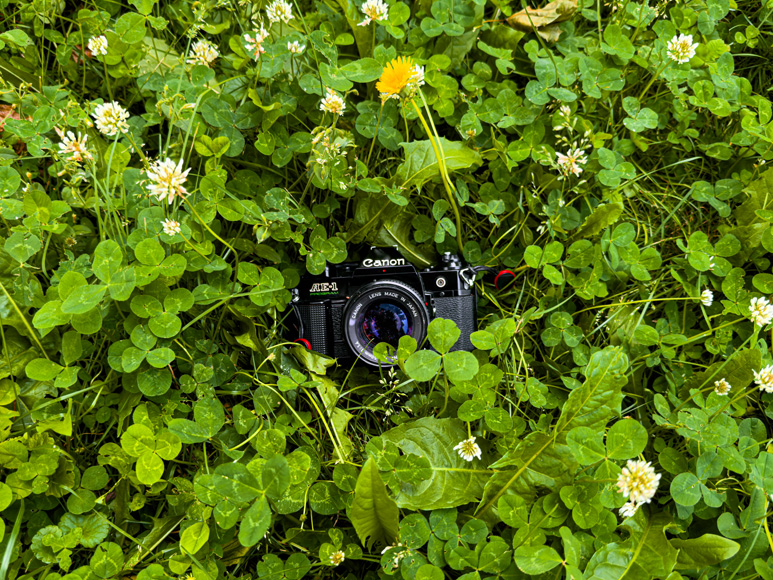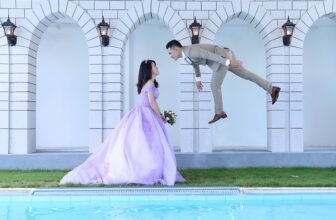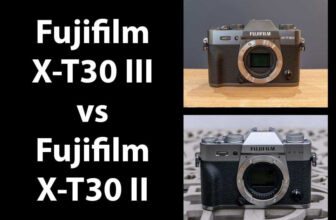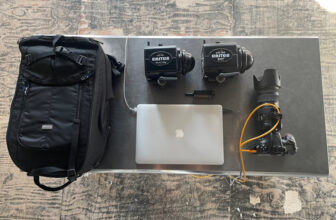
The world of film photography is full of iconic cameras and my Canon AE-1 Program review gets to show off by far one of the best!
The Canon AE-1 debuted over 40 years ago and it’s still regarded as one of the best automatic film cameras for beginners and pros alike.
HIGHLY RECOMMENDED
Iconic film camera with a classic design that’s versatile, affordable, and easy to use.
I’ve shot just about every type of film camera there is out there, and the AE-1 is by far one of the easiest models to shoot with.
If you’re thinking about picking up the AE-1 as your first (or a new-to-you) film camera, my guide is going to cover everything you need to know about this classic camera.
Canon AE-1 Program Review | Intro
The Canon AE-1 Program is stylish, tough, and friendly for all film skill levels. This is one of the cameras I recommend people get after they graduate from Film 101.
Here’s a quick breakdown of the pros and cons before I get into the details:
- Friendly for beginners
- You can shoot in manual mode for full control
- Thriving Canon AE-1 scene means troubleshooting is one internet search away
- Solid mid-budget choice
- Canon FD lenses tend to be comparatively affordable
- Iconic style serves where other film cameras look bland
- Electronics have gotten harder to repair as the years go on
- Can’t shoot faster than f 1/1000
- Flash sync speeds are pretty limited even when compared with later-model Canon film cameras
- There are cheaper film cameras out there like the Canon EOS Rebel XS
This is a now-vintage film camera, so don’t expect these specs to look like the features offered by a cutting-edge mirrorless. In the world of film photography, the simplicity of the camera belies its potential.
| Specification | Stat |
| Dimensions | 87 × 141 × 47.5 mm |
| Weight (without lens) | 590 grams |
| Light Metering | EV1 to EV18 @ ASA 100 |
| Speed | ISO 25 to 3200 |
| Format | 35mm Film |
| Lens Mount | Canon FD |
| Battery | 4LR44 6v |
| Exposure | Manual Exposure and Shutter Priority Program Mode |
| Focusing | Manual |
| Flash | Hotshoe, PC Socket @ 1/60s sync |
| Multiple Exposures | Yes, but you have to “trick” the camera to do it. Mini tutorial on that later in this review |
Build & Appearance
The Canon AE-1 Program is one of the best-looking 35mm film cameras ever made. Period.
Does it look just as good in the hands of a runway photographer as it does in the hands of a nature photographer who’s been camping on-site for weeks? Yes.
There are more interesting niche cameras and toy cameras, but nothing looks as cool and classic as this 35mm. You’d have to break the bank for a Leica to get anything more stylish.
Now, I can gush all day about the elegant design or how good it feels to hold, but does the build quality reach such heights?
This camera is built like a tank. I have dropped this thing in ways that are honestly embarrassing and it has a scratch for it. The internal mechanical components have been protected from not only my occasional fumbling but from that of all the previous owners as well.
I’ve had a few of these over the years and gotten to handle plenty of them while shooting with other photographers. On average, they all seem to hold up despite being vintage cameras with countless prior owners.
The only thing I would say you have to expect is some clouding or damage to the viewfinder.
It won’t affect your shots, but you have to learn how to “see through the fog” with some of these older or vintage film cameras.
Ergonomics & Handling


This camera handles like a dream. I would pick this as my single best camera in terms of ergonomics!
Imagine a film camera in your mind. Reach out and grab it. Feel where the shutter speed dial is, imagine readying your shutter release button, adjust your focus, take a shot. There’s a good chance that the camera you just envisioned is the Canon AE-1.
It’s so easy to shoot with this camera. The dials and buttons are all in the right place and respond smoothly without feeling like they’re constantly slipping past the settings you want.
I really want to talk about the weight of this camera for a second. I have a problem with mirrorless cameras where the camera body itself is nearly weightless and the lens winds up making up essentially all of the weight while shooting.
Some mirrorless cameras feel like a knife poorly balanced. The AE-1 Program is the opposite. I’ve shot with massive telephoto lenses and the FD equivalent of Canon’s nifty fifty. The balance with all of these lenses is just right.
Focus Performance


Sharpness and focus are going to depend so much on your lens selection and your film stock.
This is a fully manual camera with no autofocus. The focus doesn’t have much to do with the camera body itself and is all about what lens you’re using.
Unlike some EF mount lenses, which are notorious for focus creep over time, FD lenses are built tougher. I have shot some that are a bit tight, but that’s just a sign they are in need of regular maintenance.
These cameras focus by using a visible focus graphic that you can see, but it won’t show up in your shots. You just need to make sure the bars are lined up, and your shot is good to go.
If you’ve never shot manual, I highly recommend shooting full manual focus on a digital camera before trying it on film.
Your smartphone camera can even be manually focused depending on your camera app—get a third-party app with manual focus options to get a head start on this core camera skill.
Low Light Performance


The best thing about shooting manual is being able to take full control of your low light exposures.
The low light potential of film cameras works a little differently than their digital younger siblings. It’s not just the body of the camera and the speed of the shutter but the type of film you use that matters.
As far as night-to-night low-light performance goes, you can’t go wrong with the AE-1. Just make sure to shoot with a higher ISO film to make the most of dim lighting.
This camera can also shoot in bulb mode with a remote release trigger. This means you could just leave the shutter open for as long as you need to get the shot. There are even photographers doing film astrophotography with this thing.
Image Quality


Very modern, very minimalist; or at least a good demo of the range of images you can get with this camera.
The body of your camera doesn’t have a lot to do with your overall image quality. As long as your shutter, metering, and timings are accurate, it’s all down to the film and the lens itself.
With that said, the body of your film camera is what you shoot through. How it feels to hold and how you feel holding it are all a part of the overall image quality.
Digital cameras have, in a way, made us overly focused on stat creep and edging out last year’s model with fractionally better performance, but older cameras still have great image quality.


This is my favorite camera for film street photography.
The biggest difference between film and digital is the variation in image quality. Anyone can shoot with a digital camera automatically dialing in all of the variables, but film requires a working knowledge of exposure, timing, and focus.
If your shots aren’t turning out, it could be a case of skill issue with a prescription of get good.


I’m happy with the composition here, but the grain was a little loud. There’s always room for variance when shooting on film.
I’ve shot countless rolls of film and I still scuff up shots and even whole rolls. Shooting film is a constant process of refining your skills, whether you’re a beginner with plenty to learn or a long-time film fan working on more nuanced changes to your shooting.
Overall Performance
I have nothing but good things to say for the overall performance of this camera. It looks good, feels good, shoots good. If you’re into film and looking for a new 35, then this is a great choice all around.
The only caveat I feel the need to add is that these are vintage cameras. Yours might have been kept in perfect condition and regularly maintained, but another might have spent the last 30 years in a damp basement shoebox.
Always take your vintage camera gear in for a tune-up. At the very least, there’s a good chance that your light seals need to be changed—that’s always the first thing to go on these older cameras.
Program Feature and Shooting Double Exposures
Let me tell you a little secret about the Canon AE-1… They put a microprocessor, yeah, a real computer chip, in this camera! Isn’t that futuristic and high-tech?
Well, that might not sound particularly interesting, but the AE-1 was the first SLR with a microprocessor. When this camera came out, it was downright Jetsonian.
That microprocessor controls the shutter priority mode and the program mode. Shutter priority is exactly what it sounds like, but Program mode is a bit more interesting.
Program is a combination of shutter and aperture priority. You need to make sure your FD lens is set to “A” for aperture priority mode to get this to work.
This still requires manual focus, so it’s not a true automatic mode, but this is arguably the most forgiving system for learning the basics of film photography.
Canon AE-1 Multiple Exposures
Alright, here’s a three-step method for hacking the Canon AE-1 to shoot multiple exposures.
- Take your first shot.
- Turn the film rewind crank back slightly to put tension on the film.
- Hold the rewind crank in position, press the film rewind button, and arm the film advance lever. This tricks the camera into thinking you’ve advanced frames while keeping things locked in place for a double exposure.
How I Tested the Canon AE-1 Program
I’ve been shooting on the AE-1 Program for a few years now. I’ve taken this thing everywhere from the mountains to fun shoots for local bands.
Based on my experience and the experience of other photographers I know, there’s pretty much nothing you can’t shoot with this camera. It was a popular choice for professionals and casual photographers back in its day and that still holds up today.
I rarely use this camera for professional work, but that’s just a preference. I know a few photogs who use the AE-1 for weddings! If you’ve ever shot a wedding, you know you’re putting a lot of faith in a vintage camera for that work.
Canon FD Lenses
There are over 130 Canon-brand FD mount lenses to choose from in the decades-long run for this mount. You can shoot as wide as 7.5mm and as long as 1,200mm with a massive telephoto lens for the FD mount.
FD mount lenses tend to be more affordable than not. You’ll wind up spending up to around $700 for one of the more specialized lenses like the 600mm, but a 50mm FD lens won’t cost more than $50.
Despite being retro hardware, these lenses are still in great shape. Keep an eye out for fungus, damage to the glass, and problems with the blades.
Most problems with vintage glass can be easily cleaned or repaired, but cracks and scratches to the glass are usually unfixable.
With that said, a “broken” vintage lens can sometimes create beautiful results. I shoot on an Autographic that’s over 100 years old, and the fogged-out lens creates a hauntingly beautiful haze over all my shots.
Alternatives to Canon AE-1
The hardest part of writing this guide was coming up with alternatives to the Canon AE-1. This film camera isn’t exactly new and there have been decades of film cameras since this camera debuted in the ’80s to compare it to.
I looked at Olympus cameras, Nikon cameras, and pretty much everything else capable of analog photography to see how it compared to this pioneer of automatic modes.
I chose to highlight a few alternatives for the budget-conscious, photographers who prefer non-Canon brands, and anyone who wants a film camera that costs as much as a used car.
- Best Full-Feature Budget Alternative—I’d go for the Canon Rebel XS for a budget 35mm camera that still has all the features you need. This option works even better when you factor in the Rebel XS uses Canon EF lenses that you might have from your DSLR days. I personally shoot with my Rebel XS for professional film work.
- Best Nikon Alternative—The Nikon F3 is widely regarded as one of the best vintage 35mm film cameras ever made (if not the best). I’ve had the pleasure to shoot with one on a cross-country road trip and it was an absolute dream. If Canon isn’t your scene or you want something to go with your Nikon lenses, the F3 is a great choice.
- Ultra-budget Alternative—Literally any working 35mm camera. You can snag a functional 35mm camera for less than 10-15 bucks on eBay or your local thrift store. That will get you started shooting 35 while you save up for something like the AE-1.
- Best High-end Alternative—If budget doesn’t matter—and you’ve already picked up the AE-1—then flex and get the Leica M6 Rangefinder. Costing nearly a humbling $6,000, this camera is fully mechanical and engineered to perfection. Lens sold separately.
Value for Money
You’re going to spend around US$150-$300 on a Canon AE-1 Program with a basic 50mm lens. Adjust for inflation, the AE-1 would cost around $3,500 new today. A few hundred isn’t bad after we do a little photographer math.
The value is still extremely good for this retro camera. When a brand new mirrorless for digital photography could run you in the thousands, why not embrace the world of physical media for a fraction of the cost?
You get a shutter priority mode, a program mode, and a sense of style that other cameras just aspire to. This could be your first film camera or another one of many Canon cameras, but either way, this one is a must-have for the price.
Canon AE-1 Program Review | Conclusion
The Canon AE-1 Program is easily one of the best film cameras for your beginner or professional film photographer. This is more than just one of those old cameras that’s cool to post about on social media; it’s a piece of photographic history and a great daily shooter to this day.
The price is about mid-level for these kinds of vintage cameras and it’s a great way to force yourself to master the basics of exposure, focus and aperture selection.
The onboard controls give you plenty of options for masting shutter speed or aperture priority shooting without the clutter of modern cameras.
I fully recommend this camera to anyone looking to jump into film, whether this is your first camera or you’re looking for a good camera that can open that film door—no pun intended.
HIGHLY RECOMMENDED

Iconic film camera with a classic design that’s versatile, affordable, and easy to use.
Credit : Source Post









